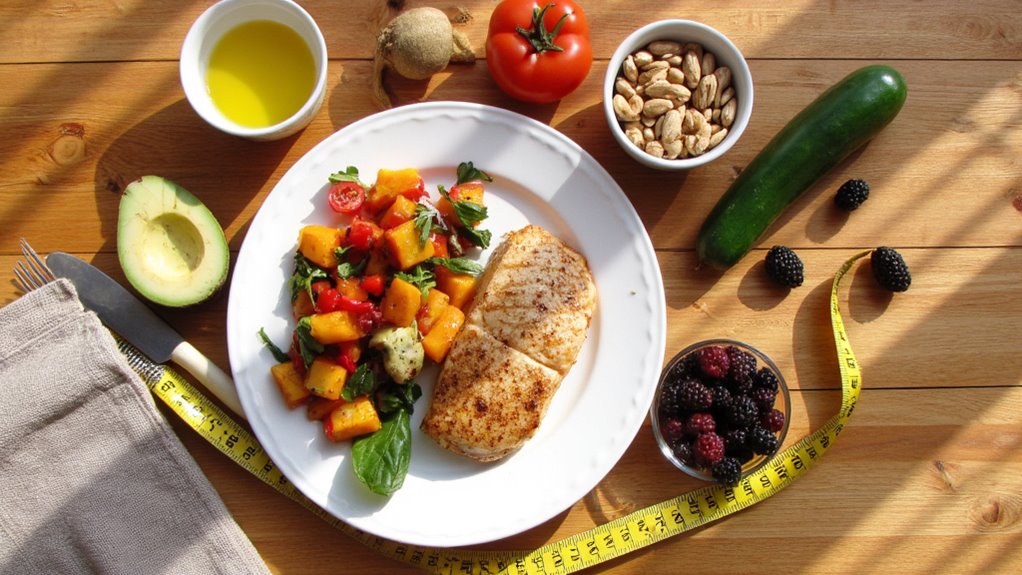This content is for informational purposes only, not medical advice, and may include affiliate links. We may earn a commission at no extra cost to you. See our Disclaimer for details.
Picture the frustrating battle against stubborn belly fat: diet after diet failing to trim your waistline despite your best efforts. You’re not alone in this struggle, as visceral fat—the dangerous type surrounding your organs—responds differently to dietary interventions than subcutaneous fat. Research from the Harvard T.H. Chan School of Public Health suggests that “targeting inflammation through specific anti-inflammatory foods may be the missing link in effective abdominal fat reduction.” The right nutritional approach can activate your body’s fat-burning mechanisms, particularly in the midsection, where health risks are highest.
In a Nutshell
- Prioritize soluble fiber (10g daily) from oats, berries, and legumes to reduce visceral fat by up to 3.7%.
- Increase protein intake to enhance satiety, boost metabolism, and target abdominal fat specifically.
- Limit refined carbohydrates and added sugars which trigger insulin spikes and fat storage.
- Include healthy fats and omega-3 fatty acids to combat inflammation associated with belly fat accumulation.
- Front-load calories earlier in the day while practicing mindful eating and portion control for effective results.
Understanding the Science of Belly Fat Loss
Why does belly fat seem so stubbornly resistant to diet changes when other body areas respond more quickly? The answer lies in its nature—visceral fat surrounding your organs is metabolically more active than subcutaneous fat. This active belly fat increases your risk of heart disease and diabetes, requiring specific dietary interventions.
Your most effective strategy involves increasing soluble fiber (10g daily) and protein-rich foods while reducing refined carbohydrates in favor of whole grains. Research shows high-protein diets enhance peptide YY release, decreasing abdominal fat accumulation, while fiber can reduce belly fat by 3.7% over five years.
Complement these dietary choices with at least 300 minutes of weekly aerobic exercise for best results.
Key Nutrients That Target Visceral Fat
Now that we’ve examined why belly fat behaves differently, let’s focus on specific nutrients that directly impact visceral fat reduction.
High protein intake stimulates peptide YY release, enhancing satiety while targeting abdominal fat accumulation. You’ll want to incorporate soluble fiber from oats and legumes, which research shows can reduce belly fat by 3.7% over five years through improved appetite regulation.
Healthy fats and omega-3 fatty acids work synergistically to combat inflammation that drives visceral fat storage. For meaningful results, you’ll need to limit added sugars, particularly in beverages, while maintaining a balanced diet that prioritizes these fat-fighting nutrients.
Foundational Eating Principles for Waist Reduction
Establishing a sustainable approach to waist reduction requires mastering several foundational eating principles that work synergistically to target abdominal fat.
Your dietary choices directly influence visceral fat accumulation, which responds well to strategic nutrition modifications combined with regular exercise.
The food on your plate directly shapes your midsection, with smart nutritional choices being the key to dismantling stubborn belly fat.
- Prioritize soluble fiber sources like berries, legumes, and oats that create lasting satiety and can help reduce belly fat by 3.7% over five years.
- Increase protein intake from quality sources to boost metabolic rate and regulate hunger hormones.
- Eliminate refined carbohydrates and added sugars that trigger abdominal fat storage.
- Incorporate healthy fats that support hormonal balance and reduce inflammation.
- Maintain consistency with a balanced diet that supports your exercise regimen.
Strategic Meal Timing and Portion Control
Beyond mastering what you eat, understanding when and how much you consume plays a significant role in abdominal fat reduction.
Strategic meal timing, particularly front-loading calories earlier in the day, promotes fat loss while reducing harmful sugar intake and stabilizing blood sugar levels throughout your day.
Research confirms that practicing portion control by reducing serving sizes 25% creates the necessary caloric deficit without sacrificing satiety.
You’ll benefit from incorporating protein-rich breakfasts, which diminish cravings and prevent overeating at subsequent meals.
Additionally, adopting mindful eating techniques—paying attention to hunger cues and slowing down during meals—enhances your awareness of consumption patterns, supporting your belly fat reduction goals while maintaining metabolic health.
Hydration’s Role in Abdominal Fat Management
Proper hydration represents a surprisingly powerful, yet often overlooked factor in your battle against stubborn belly fat. Research demonstrates that drinking 500 ml of water temporarily elevates your metabolic rate by approximately 30% for 30-40 minutes, actively promoting visceral belly fat oxidation through enhanced calorie burning mechanisms.
You’ll experience a significant reduction in calorie intake—about 13%—when consuming water before meals, supporting your healthy weight goals.
- Water coursing through your system, flushing toxins while revving your metabolism
- Clear, pure hydration nourishing thirsty muscles during intense abdominal workouts
- Crystal streams of water diluting hunger signals that might otherwise derail progress
- Life-giving liquid supporting your body’s natural fat-burning processes
- Invigorating currents maintaining ideal cellular function for abdominal fat management
Complementary Lifestyle Factors for Optimal Results
While hydration forms a foundation for metabolic health, your battle against stubborn belly fat requires a comprehensive approach that extends well beyond the water bottle.
Regular aerobic activity, performed for at least 30 minutes daily, effectively reduces waist circumference by targeting visceral fat deposits.
Daily aerobic exercise directly attacks dangerous visceral fat, shrinking your waistline where it matters most.
Complement this with resistance training 2-3 times weekly to enhance body composition and boost metabolic rate.
“Sufficient sleep, 7-9 hours nightly, is non-negotiable for hormonal balance,” notes weight management experts, who also emphasize the need to manage stress through practices like yoga.
When combined with staying hydrated, these lifestyle factors synergistically reduce appetite and optimize your health outcomes.
Frequent Questions and Answers
What Diet Burns the Most Belly Fat?
“You are what you eat!” Combine intermittent fasting with low carb diets, high protein meals, and Mediterranean nutrition. Adopt fiber-rich foods, healthy fats, portion control, sugar reduction, hydration importance, and meal prepping.
Which Is the Best Diet Plan to Reduce Belly Fat?
For reducing belly fat, combine keto benefits, Mediterranean influence, and intermittent fasting. Include plant-based proteins, healthy fats, fiber intake, portion control, smart meal timing, sugar substitutes, and prioritize hydration importance.
What Is the Best Thing to Eat to Lose Belly Fat Fast?
You’ll lose belly fat faster by focusing on lean proteins, whole foods, and healthy fats. Control portions, boost fiber intake, reduce sugar, manage stress, stay hydrated, and time your meals with an anti-inflammatory approach.
How Can I Reduce My Tummy in 7 Days?
Time to melt that stubborn pouch! Combine intermittent fasting with daily HIIT workouts while you’re boosting hydration habits. Don’t forget herbal teas, stress management, quality sleep, portion control, and mindful eating for quick results.


















